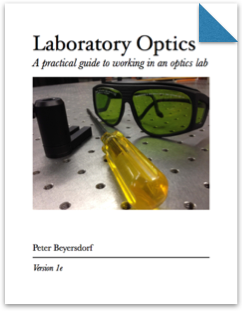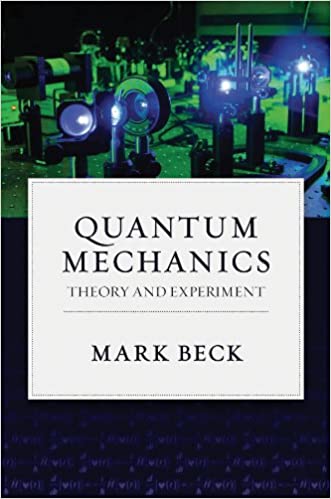PHYS 317: Quantum Optics
(The Momentum of the Photon)
- Each student is expected to grapple with computers in multiple ways: "The future of Quantum Optics is programmable!" - G.C. Spalding
- Each student is asked to take on significant responsibility for completion of the instructional lab modules, putting in time outside of lab section meetings, as needed.
- Each student is
expected to take on the role of a discovering experimentalist, examining
the large amount of data collected in lab and/or provided by readings, and
presenting analysis of this data (along with new conceptual material)
to the rest of the class.
The IWU Catalog states that, "Ideally, all courses will make approximately the same total demands upon a student’s time: ten to twelve hours per week per course (including scheduled class meeting time needed to complete all assignments) as a rule of thumb during a regular semester."
Practical Optics Advice:
Laboratory Optics, by Peter Beyersdorf, is an inexpensive e-book with nice, short videos full of advice for hands-on grapplings with optical systems. This will prove to be an invaluable resource for you!

Primary Text:
Quantum Mechanics: Theory and Experiment, by Mark Beck. (Personally, I got an eBook version of the text from Kindle, which I read on my laptop)

The Beck Lab website can prove a useful resource. ...Definitely, though, you will need to download (and make use of) OUR SET OF ESSENTIAL NOTES prepared during previous work at IWU!
The first chapter of this IWU Senior Thesis is your guide to this course! The second chapter is really useful for work with a Spatial Light Modulator (SLM) — which is also part of this course!
As the primary text focuses almost exclusively on Quantum Optics, the instructor will heavily supplement the text with discussion materials dealing with experiments where laser beams are used for the transfer of energy, linear momentum, spin angular momentum, and/or orbital angular momentum. Students will also be asked to design, assemble, and test components appropriate to next-generation communications systems, explicitly asking about the "INFORMATION CONTENT" that might reasonably be associated with a single photon, and how that information might be physically encoded, held, or erased.
Students will perform single-photon measurements, as well as measurements of the energy, linear momentum, and angular momentum transmitted by laser beams, ...clarifying principles underlying emerging quantum technologies. Such a course is unique, in that it presents quantum optics alongside a parallel discussion of classical electrodynamics, which is here presented as a story of energy and momentum. The aim is to leverage a clear physical understanding provided by analysis of laser beams, so as to provide context for our (ongoing) discussions of some of the weirdness of modern physics, which emerges quite strikingly at the single-photon level.
So, in addition to covering the formalisms of Quantum Optics treated in Mark Beck's text, this course also invites students to take up experiments involving the transfer of momentum carried by laser beams. Toward that end, students will design, assemble, and test components for applied optical systems appropriate to highly dexterous micromanipulation of various types of micro- and nano-scale samples, requiring discussion (and analysis) of the "violence" associated with thermal fluctuations at the nano-scale, and how recent fluctuation theorems lead us to an appreciation of how an arrow of time emerges.
In parallel, students will work their way through doing (and thinking about) a series of Quantum Optics experiments aimed at proving that they can truly study single-photon quantum states, including superpositions and entangled states.
What are the practical consequences of your answers to each of the following
questions?
- What is a photon? Do you think a single photon can meaningfully be said to
have a shape? A size? Is a wavefunction "real"?
Is reality overrated?
- What experiments lead us to believe that a photon exists? As Carl Sagan put it,
"extraordinary claims require extraordinary evidence." Are
different kinds of experiments giving us consistent information? (It may
help to ask an analogous question: what is an electron? What experiments lead us to
believe that an electron exists? etc.)
- A wavefunction is something that is "smeared
out" in space, right? So, what do we mean by discussing the velocity
of something that doesn't have "a" position? (You might also wonder whether
the charge associated with an electron wavefunction is similarly "smeared
out" and, if so, do the spatially separate parts repel
one another? That is, can a single electron do work on itself?)
What is the wavefunction telling us, anyway?
- Do you think a single proton can meaningfully be said to have a size? There are people who are quite puzzled about the size of the proton. What do you think is going on? Does any part of that argument pertain to our consideration of the photon?
- Look back at
your Intro-level Physics text: how and why was the concept of momentum
first introduced? (While you're at it, review how the concept of energy
was introduced.)
- What do we mean by discussing the momentum of a massless
particle?
- Can a single photon have angular momentum? If not, why not? If so, is there
any limit
to how much angular momentum a photon can have?
- Can a single photon exert a force?
- Look back at
your Modern Physics text: how was the operator structure of quantum
mechanics first introduced? - Do you think it should be the same for
massive and for massless particles?
- Could Schrödinger's cat exist in real life?
- Is everything entangled with everything? What do we mean by entanglement?
Can the universe evolve towards a state of higher entanglement?
Is there any statement we can make about how the degree of entanglement in the universe is likely to change?
- Where does the arrow of time emerge from, anyway?
- What limits entanglement?
What is the largest system for which
macroscopic quantum coherence has been compellingly demonstrated? Could a sentient being become entangled?
- What are some models that might provide a physical origin for wavefunction
collapse?
- Could collapse result from some unknown cosmological field at work? The 2020 Nobel laureate Roger Penrose asks, Could gravity induce quantum collapse?
- When a measurement is made on an entangled wavefunction,
what is the speed at which the wavefunction collapses?
- Can anything mover faster than light? If not, why not? If so, is that a problem?
- As a photon moves away from the Earth, given that the Earth's gravitational field
warps spacetime, does it make sense to say that
the photon accelerates? If so,
is there any limit as to how fast (or slow) the photon can go? If not, why
not?
How do you envision a single photon?

Do you think a single photon can meaningfully be said to have a shape?
A size?
...You might also be interested in discussing articles we've produced on these topics:
Your Dungeon Master: Gabe Spalding

Office: CNS room C006B.
Tel: 556-3004.
Electronic communication: gspaldin@iwu.edu





